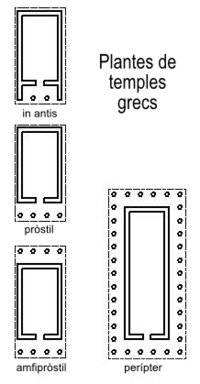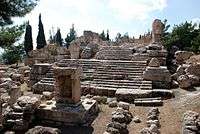Temples of the Beqaa Valley
.jpg)



The Temples of the Beqaa Valley are a number of shrines and Roman temples that are dispersed around the Beqaa Valley in Lebanon.[1]
Surveys
Documentation of the temples in the Beqaa Valley area began in the 19th century, with surveys by Edward Robinson in 1852 CE and Sir Charles Warren.[2][3] The most notable of the temples of Venus, Bacchus and Jupiter at Baalbek were thoroughly studied by Paul Collart and Pierre Coupel.[4][5] Ten sacred sites were also documented by Daniel Krencker and Willy Schietzschmann in 1938.[6] Maurice Tallon published an itinerary of the sanctuaries in 1967 with details of the paths to reach them.[7] George F. Taylor provided a pictorial guide in the late 1960s with more recent information coming from Shim'on Dar in 1993 and epigraphic surveys in 2002 and 2003.[8]
The Seleucids occupied the area after 200 BCE, shortly after which the Ituraeans developed a principality in the area until the fall of Chalcis when the territory passed to the Herodian kings Agrippa I and Agrippa II. After the end of the first century CE the territory became jointly controlled by the cities of Damascus, Sidon and Paneas. It is thought that the area was inhabited continuously until the third century CE. Although the sites may have been built on previous layers of architecture, the current temples are predominantly considered to be of Roman construction and were largely abandoned after the fourth century CE during the Byzantine era.[1]
The temples were often connected with ancient occupational sites. Olivier Callot and Pierre-Louis Gatier argued that several of the temple sites might have been mistaken for monumental tombs as Roman mausoleums such as Saidnaya have been found in Lebanon.[9] Taylor held the view that the religious architecture was the responsibility of "the hand of a single master builder" but was not able to answer the question of why so many shrines should be concentrated in the area.[8] Henry Seyrig, when reviewing Krencker and Zscheitzmann's "Romische Tempel in Syrien" highlighted that "the clue to an important social and economic change that would deserve to be one day the focus of a study". There is still a deplorable lack of a comprehensive study into the history, archaeology, architecture of these buildings and ancient sites, or the religious life of the people who used them.[1]
Temple types
The typology of the temples has been studied and they are generally divided into Antae, Prostylos or Peripteral types. Antae temples have side walls that extend to form a porch at the front or rear (or both) and terminated in pilasters that were called the antae.[10] If columns were placed in advance of the walls or antae, the temple was termed Prostylos and if columns surrounded the temple it was termed Peripteral. The peripteral type is thought to be the most perfect form of temple and the best preserved of this type is the Temple of Bacchus at Baalbek.[8][10]
Worship
It was the opinion of Edward Robinson that worship was not conducted within the temples, but rather outside it.[8] The temple was the domain of the priests where they venerated a cult statue.[8] Worshippers gathered around the temple at ceremonial times and hence there was no need for divisions within it, such as the aisles of modern churches.[8] The cult images, along with temples themselves would often be aligned so that the sun would illuminate them at certain times of day and year.[8] George F. Taylor was of the opinion that a sacrifice would be made when certain areas of the temple became illuminated.[8] He suggested that a "Minister of Works" may have been responsible for local civil engineering in Ancient Roman times.[8]
Temple groups
George F. Taylor divided up the Temples of Lebanon into three groups, one covering the Beqaa valley north of the road from Beirut to Damascus. Secondly a group to the south, including the Wadi al-Taym known as Temples of Mount Hermon. Thirdly a group in the area west of a line drawn along the ridge of Mount Lebanon that includes Makam Er-Rab, Sfire, Kasr Naous, Amyioun, Bziza, Batroun, Edde, Mashnaqa, Yanuh, Afka, Kalaat Fakra, Kalaa, Sarba, Antoura, Deir el-Kalaa, Shheem and the coastal plains of Beirut, Byblos, Sidon, Tripoli, Lebanon and Tyre. The Temples of the Beqaa Valley in Taylor's first group included El-Lebwe, Yammoune, Qasr Banat, Iaat, Nahle, Baalbek, Hadet, Kasr Neba, Temnin el-Foka, Nebi Ham, Saraain El Faouqa, Niha, Hosn Niha, Fourzol and Kafr Zebad.[8]
Niha Gallery
-

Roman temple of Hosn Niha, Lebanon
-

Roman temple of Hosn Niha, Lebanon
-

Roman temple of Hosn Niha, Lebanon
-
Roman temple at Niha, Lebanon
-

Statue at the Roman temple at Niha, Lebanon
-

Small lower temple at Niha, Lebanon
Baalbek Gallery
-

Temple of Jupiter
-

Temple of Bacchus
-

Exterior of Baalbek temple. Shaft of unknown function leads to the interior of what is now the museum.
-

Sculpture of an unknown God at Baalbek
-
.jpg)
Roof sculpture of Ceres at Baalbek
-
.jpg)
Sculpture of Mark Antony at Baalbek
-
.jpg)
Sculpture of Cleopatra at Baalbek
See also
References
- 1 2 3 Ted Kaizer (2008). Aliquot, Julien., Sanctuaries and villages on Mount Hermon in the Roman period in The Variety of Local Religious Life in the Near East In the Hellenistic and Roman Periods. BRILL. pp. 76–. ISBN 978-90-04-16735-3. Retrieved 17 September 2012.
- ↑ Edward Robinson (1856). Biblical researches in Palestine and the adjacent regions: a journal of travels in the years 1838 and 1852. J. Murray. pp. 433–. Retrieved 17 September 2012.
- ↑ Sir Charles William Wilson (1881). Picturesque Palestine, Sinai, and Egypt. D. Appleton. Retrieved 17 September 2012.
- ↑ Erich S. Gruen (25 January 2011). Cultural Identity in the Ancient Mediterranean. Getty Publications. pp. 453–. ISBN 978-0-89236-969-0. Retrieved 25 October 2012.
- ↑ Paul Collart; Pierre Coupel (1951). L'Autel monumental de Baalbek. Librairie Orientaliste Paul Geuthner. Retrieved 25 October 2012.
- ↑ Daniel M. Krencker; Willy Zschietzschmann (1938). Römische Tempel in Syrien: nach Aufnahmen und Untersuchungen von Mitgliedern der Deutschen Baalbekexpedition 1901-1904, Otto Puchstein, Bruno Schulz, Daniel Krencker. W. de Gruyter & Co. Retrieved 17 September 2012.
- ↑ Tallon, Maurice., “Sanctuaires et itinéraires romains du. Chouf et du sud de la Béqa,” Mélanges de l'université Saint Joseph 43, pp. 233-50, 1967.
- 1 2 3 4 5 6 7 8 9 10 George Taylor (1971). The Roman temples of Lebanon: a pictorial guide. Les temples romains au Liban; guide illustré. Dar el-Machreq Publishers. Retrieved 18 September 2012.
- ↑ Callot, Olivier, and Pierre-Louis Gatier. "Le reseau des sanctuaires en Syrie du Nord." Topoi 9, pp. 665-688, 1999.
- 1 2 Henry Ellis (sir); British museum dept. of Gr. and Rom. antiq (1833). The British museum. Elgin and Phigaleian marbles (by Sir. H. Ellis). Charles Knight. pp. 72–. Retrieved 25 October 2012.
External links
- The Roman Temples of Lebanon by George Taylor on discoverlebanon.com
- Full text of Picturesque Palestine, Sinai and Egypt. Edited by Charles Wilson, 1881.
- Roman Temples of the Bekaa - Lebanese Ministry of Tourism Guide
